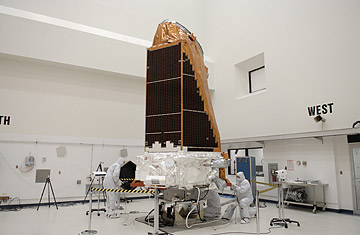
At the Astrotech payload processing facility in Titusville, Fla., workers from Ball Aerospace check the star trackers on NASA's Kepler spacecraft before testing
Think you could stare at a single spot without blinking for 3½ years? Then be glad you're not NASA's Kepler telescope, which is set to blast into space from Cape Canaveral, Fla., this Friday night. Kepler's job may sound boring to you, but what the spacecraft accomplishes could be extraordinary: the discovery of the first Earth-like planets orbiting sun-like stars. Those kinds of places might well be brewing Earth-like forms of life.
Humans have been looking for other planets ever since astronomers first turned telescopes to the sky. But once we got beyond the nine worlds orbiting our own sun — eight actually, now that Pluto's been busted down to planetoid — we had no luck. The problem is, stars are huge, and by comparison, even big planets are tiny. Squint all you want; you're not going to see them. (See pictures of Earth from space.)
That obstacle was overcome in 1995 when astronomers Michael Mayor and Didier Queloz discovered the planet 51 Pegasus b orbiting the eponymous star 51 Pegasus. The astronomers made their find not by spotting the planet directly but by measuring the minute gravitational wobbles it causes in its parent star as it orbits. With those scraps of data, they could calculate the planet's mass, velocity, orbital altitude and more.
That was big news if you were hunting for planets but no news at all if you were hunting for life. A planet with enough gravitational oomph to jiggle a star is probably a gas giant like Jupiter, orbiting so close to the fires of its sun that nothing living would have a chance. What biology needs in order to get going is a relatively small, rocky planet orbiting in what's called a star's habitable zone — a place where things get hot but not too hot, cold but not too cold. A place like Earth, in other words. In the 14 years since 51 Pegasus b was found, astronomers have counted a total of 342 planets orbiting 289 stars, but not a single one of them is of the so-called terrestrial variety. (See pictures of Saturn.)
That's what Kepler is trying to change. The new telescope looks a bit like it could be the Hubble telescope's little brother, measuring 15.3 ft. vs. Hubble's 43.5. Kepler is smaller because it carries just one main piece of scientific hardware: a light imager known as a charged couple device that detects fluctuations in light so tiny they're measured by counting the electrons they produce on a silicon surface. This will allow Kepler to spot planets by the previously invisible change in luminosity they cause as their orbit carries them around the facing side of their parent star. (See pictures of women in space.)
"If Kepler were to look down at a small town on Earth at night from space," says NASA's James Fanson, the Kepler project manager, "it would be able to detect the dimming of a porch light as someone passed in front."
Still, to make any real discoveries, Kepler will have to look at a lot of lights on a lot of porches. With perhaps 70 sextillion stars in the universe (that's 7 followed by 22 zeros), the spacecraft can't possibly survey them all. Instead, it will sample about 100,000 in a region of our solar system known as Cygnus-Lyra. That spot was chosen both because it's rich in stars and because it lies above our own orbital plane. Kepler — which will be launched into not an Earth orbit but a solar orbit — can thus simply train its gaze up and never have to worry about any bodies in the home solar system blocking its view. (See pictures of five nations' space programs.)
An unblinking look at Cygnus-Lyra is important because even if Kepler were to detect any telltale fluctuations in stellar light, that wouldn't be proof of a planet. The telescope would have to keep looking and see if the flickering is repeated roughly once a year, or about the time it would take an Earth-like planet to circle around its star and pass in front again. Record three or four such passes, and you can be pretty sure you've got a planet — hence the 3½-year mission.
"The planetary census Kepler takes will be very important for understanding the frequency of Earth-sized planets in our galaxy," says Jon Morse, director of NASA's astrophysics division.
The good thing about a census like this one is that even a few sightings can tell you a lot. Spot a handful of Earth-like planets among 100,000 stars, then factor up to 70 sextillion, and you've got whole lot of warm, cozy worlds potentially cooking up a whole lot of life. On one of those worlds, someone may even be looking back as our own planet passes in front of the porch light of our sun.
